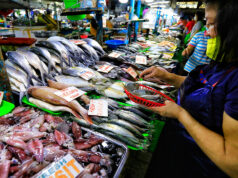Inflation slows down in February
THE GENERAL INCREASE in the prices of widely used goods and services eased in February due to slower price adjustments in the heavily weighted food and non-alcoholic beverages and select nonfood commodities, the Philippine Statistics Authority (PSA) reported, lending support to the possibility of the central bank to cut policy rates soon.
Preliminary results from the PSA showed February inflation at 2.6%, slower than January’s annual rate of 2.9% and 3.8% in February 2019.
The February reading was slower than the three-percent median estimate in a BusinessWorld poll of 17 economists conducted late last week. It was, however, within the 2.4%-3.2% forecast range given by the Bangko Sentral ng Pilipinas (BSP) Department of Economic Research for the month.
Year to date, inflation settled at 2.8%, still within the BSP’s 2%-4% target band and below the revised three-percent forecast for the entire 2020.
Excluding volatile food and energy prices, core inflation slowed to 3.2% from January’s 3.3%. So far, it averaged 3.2% for the year.
“The downtrend in the inflation was mainly brought about by the slower annual increase in the heavily weighted food and non-alcoholic beverages index at 2.1% during the month [from 2.2% in January],” the PSA said in a statement.
The PSA also noted decelerations in the annual increases in alcoholic beverages (to 18.2% in February from 19.2% in January); housing, water, electricity, gas, and other fuels (1.7% from 2.5%); and transport (1.8% from 3%).
On the other hand, the index of furnishing, household equipment and routine home maintenance saw an uptick of 3.5% in February from 3.1% a month ago.
Other indices were steady during the month, namely: clothing and footwear (2.7%); health (2.9%); communication (0.4%); recreation and culture (1.5%); education (4.7%); and restaurant and miscellaneous goods and services (2.6%).
The food-alone index also remained steady at 2.1% from the previous month, albeit slower than the 4.2% posted a year ago.
In an e-mail to BusinessWorld, Colegio de San Juan de Letran Graduate School Dean Emmanuel J. Lopez said the easing inflation in February was due to the coronavirus disease 2019 (COVID-19), which led to a slowdown in business activity.
In a report, ANZ Research economists Mustafa Arif and Sanjay Mathur said the February inflation result was a “downside surprise.”
“Inflationary pressures will likely remain modest amid lower global crude prices. The COVID-19 outbreak and its attendant impact on economic activity should also suppress price pressures, although in the near term it may enhance volatility across the components of the inflation basket,” they said.
“As such, the BSP has sufficient room to cut its policy rate further. Our current call is for the BSP to cut its policy rate by 25 bps (basis points) at the [May 21] meeting, although the continued spread of COVID-19 has increased the odds of a cut [on March 19]. A deeper rate cutting cycle is also feasible,” they added.
In a separate report, JPMorgan Chase Bank NA Singapore Branch Economist Nur Raisah Rasid said the Philippines’ inflation trajectory “looks to remain benign” as headline inflation is expected to remain at the lower end of the BSP’s 2%-4% target range this year.
Ms. Rasid added the broadening spread of COVID-19 beyond Asia last week “may pose downside risk” to its Philippine economic growth forecast of 6.2%, which was already below the government’s growth target of 6.5%-7.5%.
“Amid a well-behaved inflation trajectory, and with the [US Federal Reserve] projected to reduce the [federal funds rate] further… We recently added a 25-bp cut in the benchmark RRP (reverse repurchase rate)… in addition to our forecast for a 25-bp reduction in [the second quarter of 2020]…,” Ms. Rasid added.
The BSP’s Monetary Board will meet on March 19 to discuss policy, just hours after the US Fed’s Federal Open Market Committee is scheduled to release the decision on its monetary policy.
The rates on the BSP’s reverse repurchase, overnight lending and deposit facilities currently stand at 3.75%, 4.25%, and 3.25%, respectively.
In a statement, the BSP said risks to the inflation outlook “are expected to be weighted to the upside for 2020, but are… tilted toward the downside in 2021.”
“Adjustments in utility rates, petitions for transport fare hikes, and the impact of African Swine Fever (ASF) on meat prices are the main upside risks to inflation. The ongoing spread of COVID-19 could have an adverse impact on domestic economic activity and financial market sentiment in the coming months,” the BSP said.
In a separate statement, the National Economic and Development Authority (NEDA) underscored the need for the government to “remain vigilant and well-positioned against possible risks to inflation in the country.”
“While inflation is expected to remain well within the target for this year, government must not be complacent and ensure that strategies are well-positioned against risks brought by continuous spread of [ASF], tighter rice supply from Thailand, and the ongoing outbreak of [COVID-2019],” NEDA quoted Socioeconomic Planning Secretary Ernesto M. Pernia as saying in a statement. — Jobo E. Hernandez




